Land Law: Skeleton Argument on Behalf of Claimant for Co-Ownership of Property
VerifiedAdded on 2023/06/08
|11
|3019
|121
AI Summary
This article presents a skeleton argument on behalf of the claimant for co-ownership of property in the case of Bert and Earnest. It discusses the concept of common intention and constructive trust in land law and provides relevant case laws to support the argument. The article also presents an opposing argument that challenges the claimant's demand for co-ownership.
Contribute Materials
Your contribution can guide someone’s learning journey. Share your
documents today.
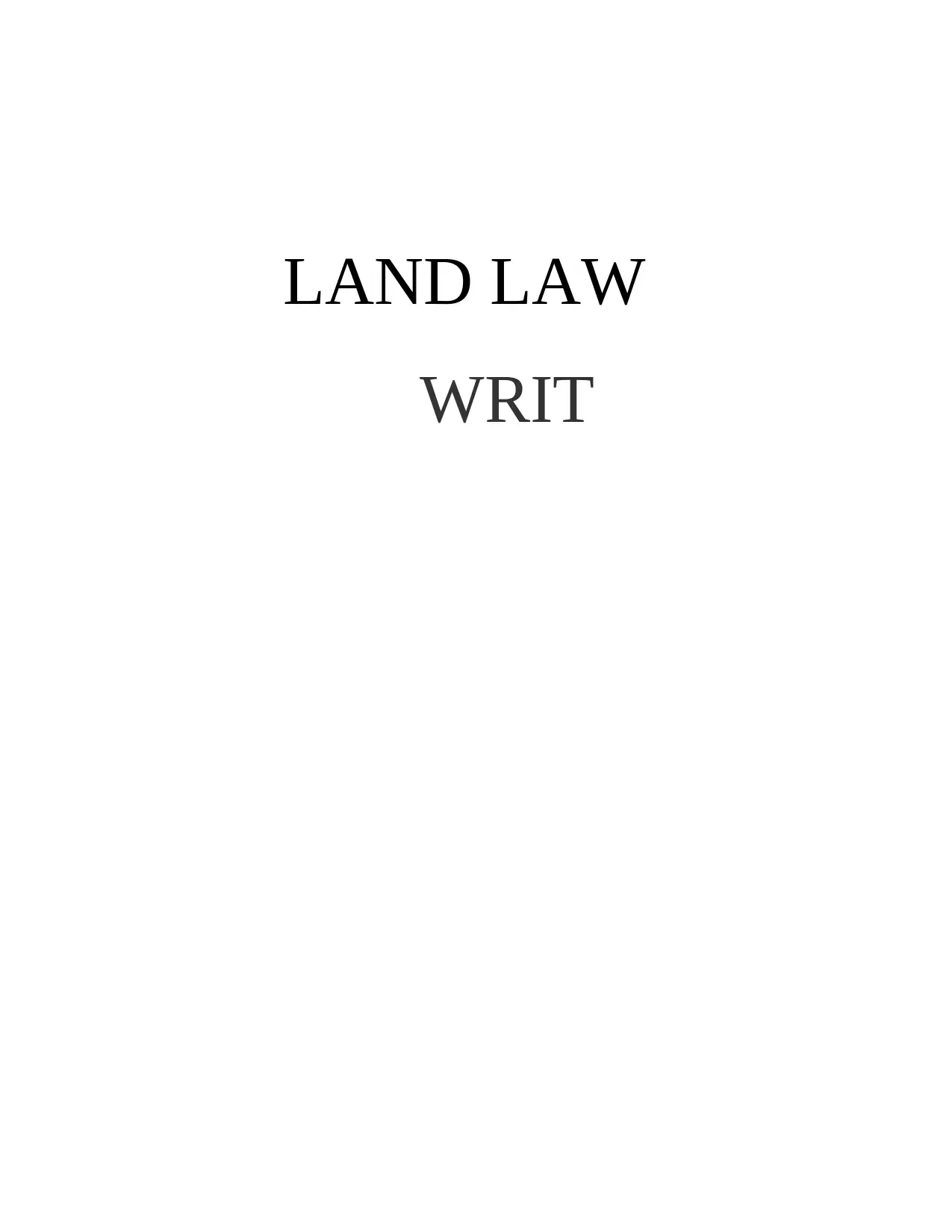
LAND LAW
WRIT
WRIT
Secure Best Marks with AI Grader
Need help grading? Try our AI Grader for instant feedback on your assignments.
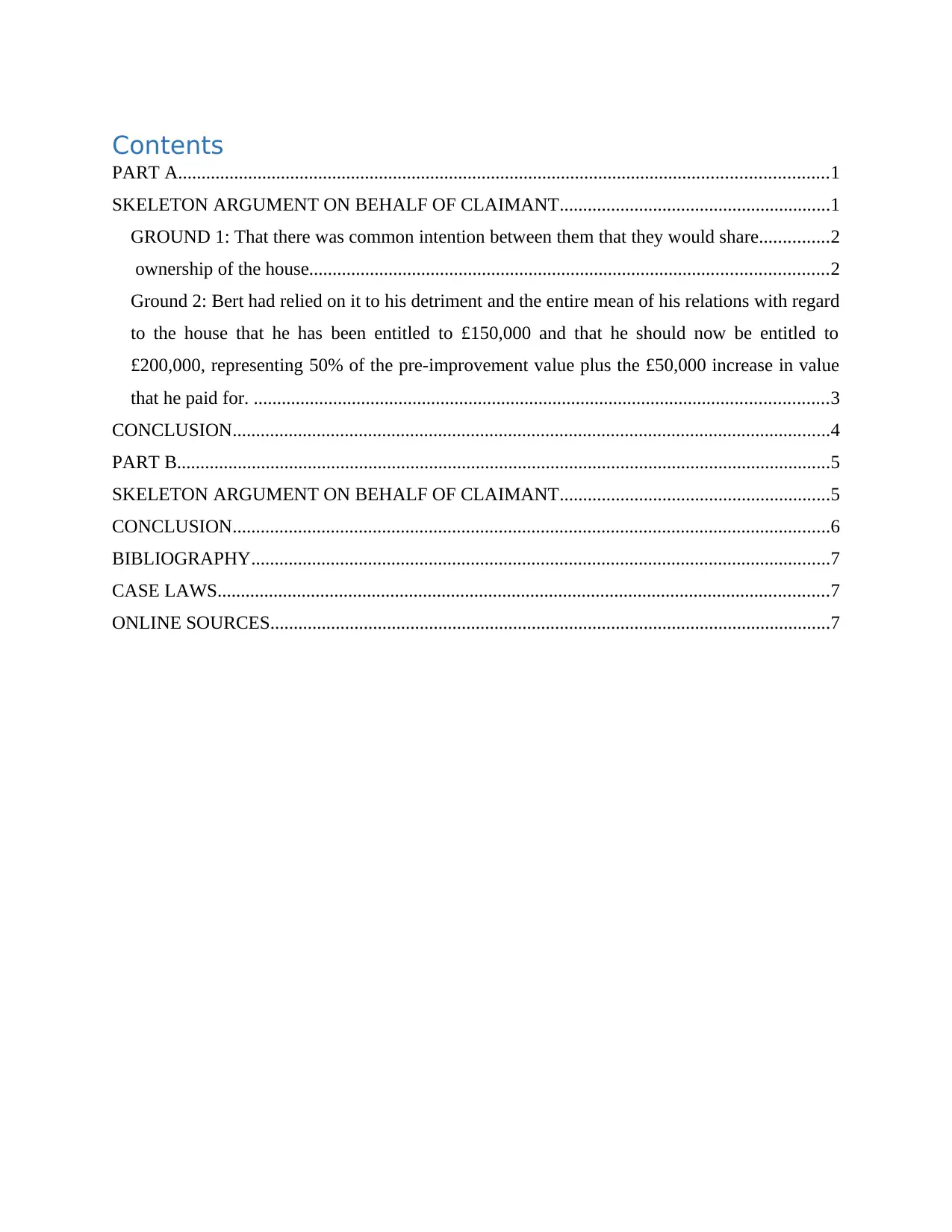
Contents
PART A...........................................................................................................................................1
SKELETON ARGUMENT ON BEHALF OF CLAIMANT..........................................................1
GROUND 1: That there was common intention between them that they would share...............2
ownership of the house...............................................................................................................2
Ground 2: Bert had relied on it to his detriment and the entire mean of his relations with regard
to the house that he has been entitled to £150,000 and that he should now be entitled to
£200,000, representing 50% of the pre-improvement value plus the £50,000 increase in value
that he paid for. ...........................................................................................................................3
CONCLUSION................................................................................................................................4
PART B............................................................................................................................................5
SKELETON ARGUMENT ON BEHALF OF CLAIMANT..........................................................5
CONCLUSION................................................................................................................................6
BIBLIOGRAPHY............................................................................................................................7
CASE LAWS...................................................................................................................................7
ONLINE SOURCES........................................................................................................................7
PART A...........................................................................................................................................1
SKELETON ARGUMENT ON BEHALF OF CLAIMANT..........................................................1
GROUND 1: That there was common intention between them that they would share...............2
ownership of the house...............................................................................................................2
Ground 2: Bert had relied on it to his detriment and the entire mean of his relations with regard
to the house that he has been entitled to £150,000 and that he should now be entitled to
£200,000, representing 50% of the pre-improvement value plus the £50,000 increase in value
that he paid for. ...........................................................................................................................3
CONCLUSION................................................................................................................................4
PART B............................................................................................................................................5
SKELETON ARGUMENT ON BEHALF OF CLAIMANT..........................................................5
CONCLUSION................................................................................................................................6
BIBLIOGRAPHY............................................................................................................................7
CASE LAWS...................................................................................................................................7
ONLINE SOURCES........................................................................................................................7
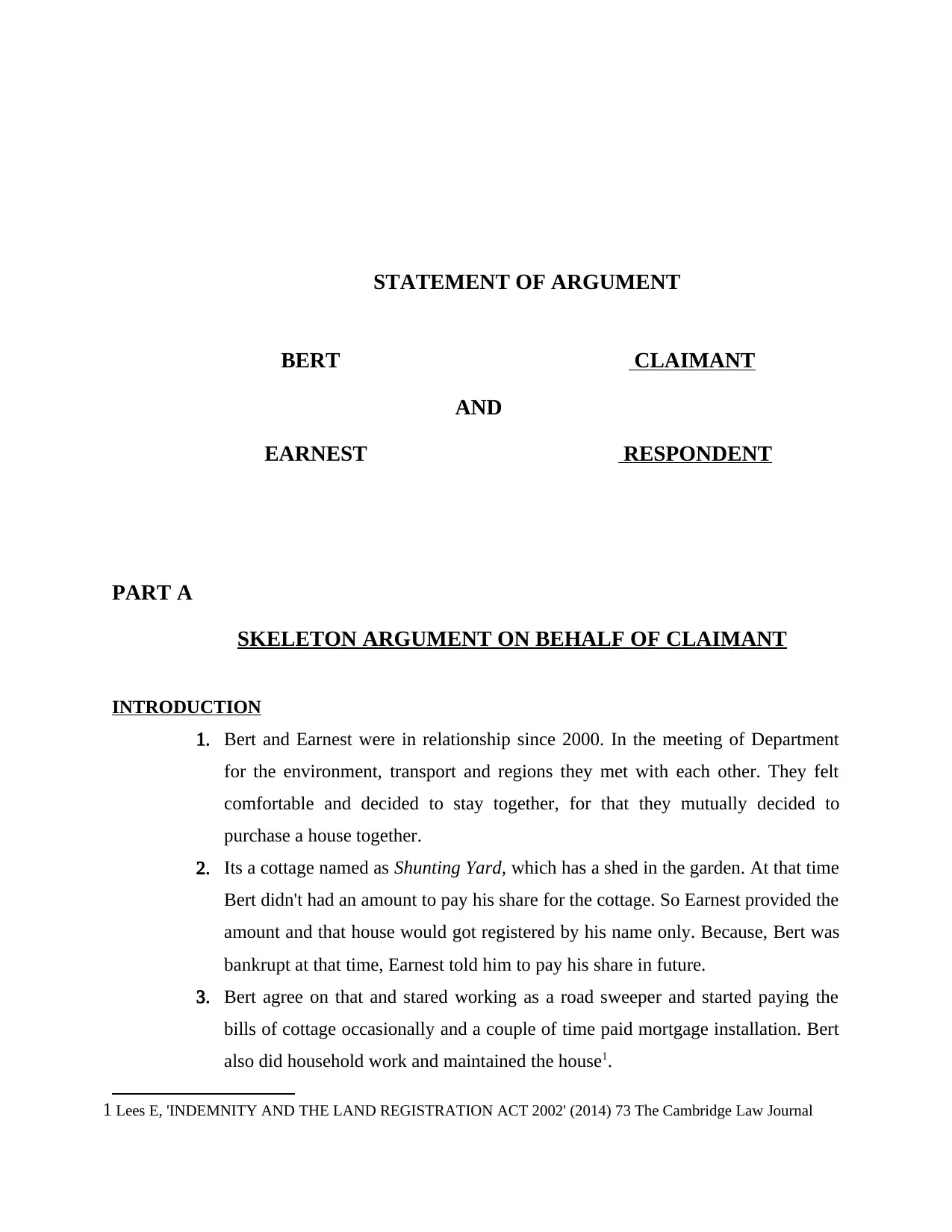
STATEMENT OF ARGUMENT
BERT CLAIMANT
AND
EARNEST RESPONDENT
PART A
SKELETON ARGUMENT ON BEHALF OF CLAIMANT
INTRODUCTION
1. Bert and Earnest were in relationship since 2000. In the meeting of Department
for the environment, transport and regions they met with each other. They felt
comfortable and decided to stay together, for that they mutually decided to
purchase a house together.
2. Its a cottage named as Shunting Yard, which has a shed in the garden. At that time
Bert didn't had an amount to pay his share for the cottage. So Earnest provided the
amount and that house would got registered by his name only. Because, Bert was
bankrupt at that time, Earnest told him to pay his share in future.
3. Bert agree on that and stared working as a road sweeper and started paying the
bills of cottage occasionally and a couple of time paid mortgage installation. Bert
also did household work and maintained the house1.
1 Lees E, 'INDEMNITY AND THE LAND REGISTRATION ACT 2002' (2014) 73 The Cambridge Law Journal
BERT CLAIMANT
AND
EARNEST RESPONDENT
PART A
SKELETON ARGUMENT ON BEHALF OF CLAIMANT
INTRODUCTION
1. Bert and Earnest were in relationship since 2000. In the meeting of Department
for the environment, transport and regions they met with each other. They felt
comfortable and decided to stay together, for that they mutually decided to
purchase a house together.
2. Its a cottage named as Shunting Yard, which has a shed in the garden. At that time
Bert didn't had an amount to pay his share for the cottage. So Earnest provided the
amount and that house would got registered by his name only. Because, Bert was
bankrupt at that time, Earnest told him to pay his share in future.
3. Bert agree on that and stared working as a road sweeper and started paying the
bills of cottage occasionally and a couple of time paid mortgage installation. Bert
also did household work and maintained the house1.
1 Lees E, 'INDEMNITY AND THE LAND REGISTRATION ACT 2002' (2014) 73 The Cambridge Law Journal
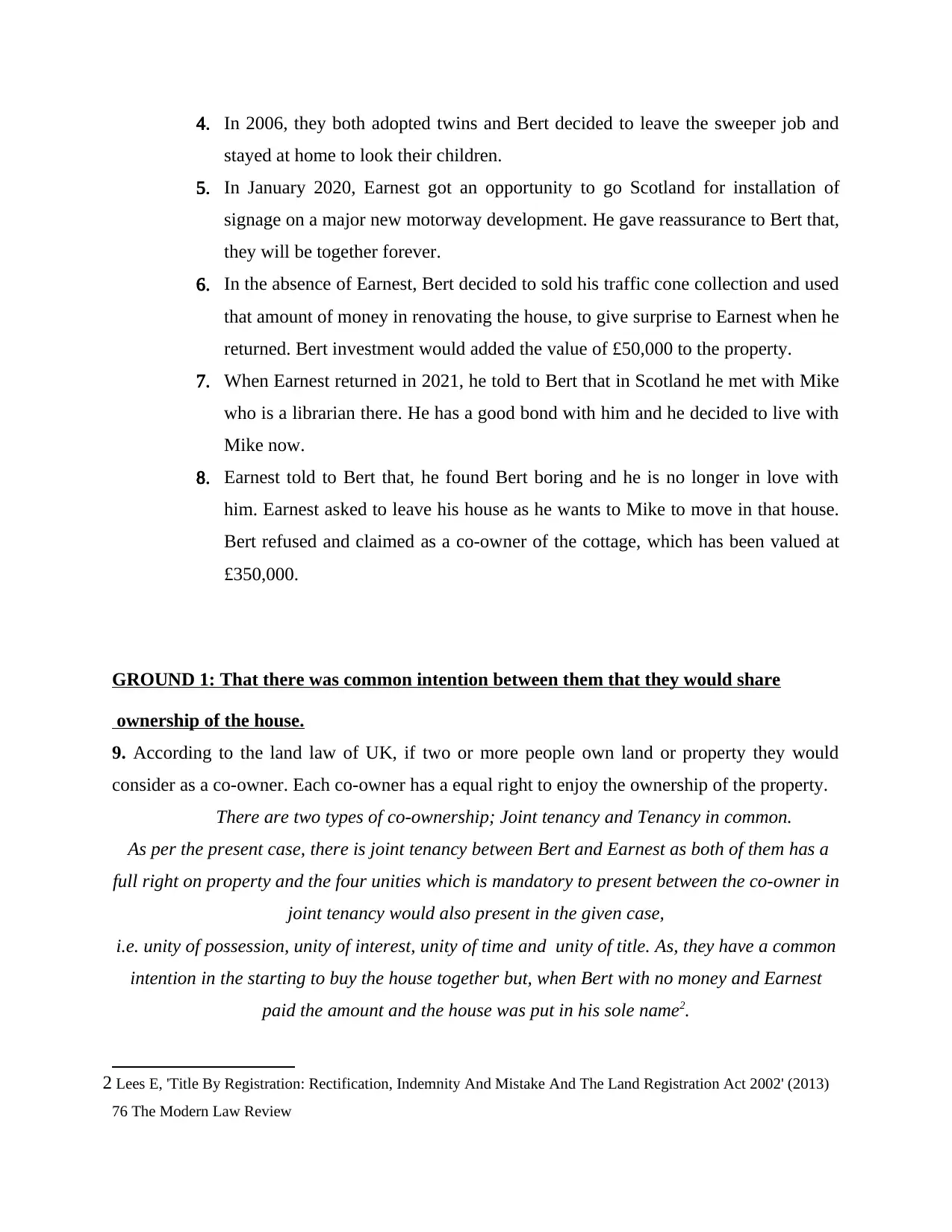
4. In 2006, they both adopted twins and Bert decided to leave the sweeper job and
stayed at home to look their children.
5. In January 2020, Earnest got an opportunity to go Scotland for installation of
signage on a major new motorway development. He gave reassurance to Bert that,
they will be together forever.
6. In the absence of Earnest, Bert decided to sold his traffic cone collection and used
that amount of money in renovating the house, to give surprise to Earnest when he
returned. Bert investment would added the value of £50,000 to the property.
7. When Earnest returned in 2021, he told to Bert that in Scotland he met with Mike
who is a librarian there. He has a good bond with him and he decided to live with
Mike now.
8. Earnest told to Bert that, he found Bert boring and he is no longer in love with
him. Earnest asked to leave his house as he wants to Mike to move in that house.
Bert refused and claimed as a co-owner of the cottage, which has been valued at
£350,000.
GROUND 1: That there was common intention between them that they would share
ownership of the house.
9. According to the land law of UK, if two or more people own land or property they would
consider as a co-owner. Each co-owner has a equal right to enjoy the ownership of the property.
There are two types of co-ownership; Joint tenancy and Tenancy in common.
As per the present case, there is joint tenancy between Bert and Earnest as both of them has a
full right on property and the four unities which is mandatory to present between the co-owner in
joint tenancy would also present in the given case,
i.e. unity of possession, unity of interest, unity of time and unity of title. As, they have a common
intention in the starting to buy the house together but, when Bert with no money and Earnest
paid the amount and the house was put in his sole name2.
2 Lees E, 'Title By Registration: Rectification, Indemnity And Mistake And The Land Registration Act 2002' (2013)
76 The Modern Law Review
stayed at home to look their children.
5. In January 2020, Earnest got an opportunity to go Scotland for installation of
signage on a major new motorway development. He gave reassurance to Bert that,
they will be together forever.
6. In the absence of Earnest, Bert decided to sold his traffic cone collection and used
that amount of money in renovating the house, to give surprise to Earnest when he
returned. Bert investment would added the value of £50,000 to the property.
7. When Earnest returned in 2021, he told to Bert that in Scotland he met with Mike
who is a librarian there. He has a good bond with him and he decided to live with
Mike now.
8. Earnest told to Bert that, he found Bert boring and he is no longer in love with
him. Earnest asked to leave his house as he wants to Mike to move in that house.
Bert refused and claimed as a co-owner of the cottage, which has been valued at
£350,000.
GROUND 1: That there was common intention between them that they would share
ownership of the house.
9. According to the land law of UK, if two or more people own land or property they would
consider as a co-owner. Each co-owner has a equal right to enjoy the ownership of the property.
There are two types of co-ownership; Joint tenancy and Tenancy in common.
As per the present case, there is joint tenancy between Bert and Earnest as both of them has a
full right on property and the four unities which is mandatory to present between the co-owner in
joint tenancy would also present in the given case,
i.e. unity of possession, unity of interest, unity of time and unity of title. As, they have a common
intention in the starting to buy the house together but, when Bert with no money and Earnest
paid the amount and the house was put in his sole name2.
2 Lees E, 'Title By Registration: Rectification, Indemnity And Mistake And The Land Registration Act 2002' (2013)
76 The Modern Law Review
Secure Best Marks with AI Grader
Need help grading? Try our AI Grader for instant feedback on your assignments.
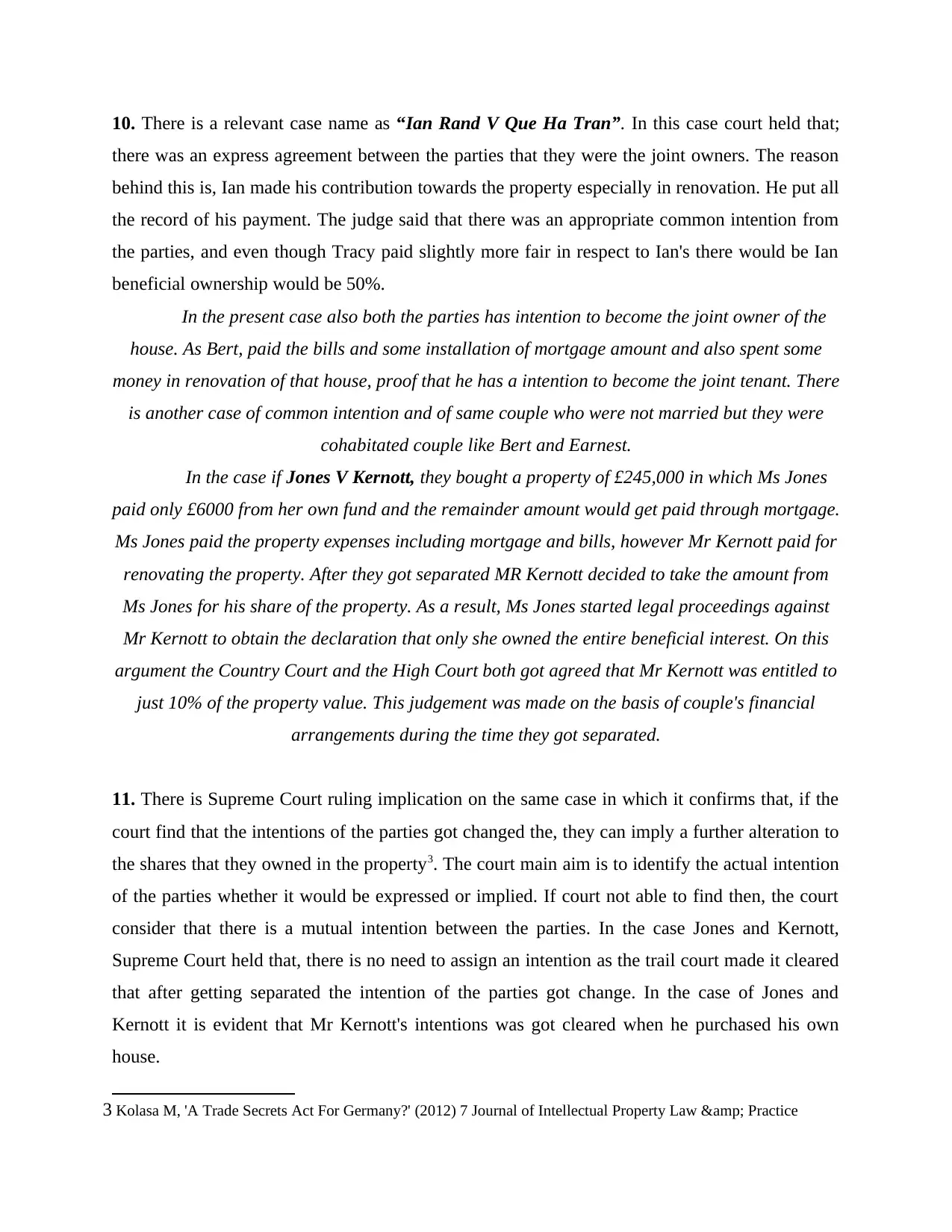
10. There is a relevant case name as “Ian Rand V Que Ha Tran”. In this case court held that;
there was an express agreement between the parties that they were the joint owners. The reason
behind this is, Ian made his contribution towards the property especially in renovation. He put all
the record of his payment. The judge said that there was an appropriate common intention from
the parties, and even though Tracy paid slightly more fair in respect to Ian's there would be Ian
beneficial ownership would be 50%.
In the present case also both the parties has intention to become the joint owner of the
house. As Bert, paid the bills and some installation of mortgage amount and also spent some
money in renovation of that house, proof that he has a intention to become the joint tenant. There
is another case of common intention and of same couple who were not married but they were
cohabitated couple like Bert and Earnest.
In the case if Jones V Kernott, they bought a property of £245,000 in which Ms Jones
paid only £6000 from her own fund and the remainder amount would get paid through mortgage.
Ms Jones paid the property expenses including mortgage and bills, however Mr Kernott paid for
renovating the property. After they got separated MR Kernott decided to take the amount from
Ms Jones for his share of the property. As a result, Ms Jones started legal proceedings against
Mr Kernott to obtain the declaration that only she owned the entire beneficial interest. On this
argument the Country Court and the High Court both got agreed that Mr Kernott was entitled to
just 10% of the property value. This judgement was made on the basis of couple's financial
arrangements during the time they got separated.
11. There is Supreme Court ruling implication on the same case in which it confirms that, if the
court find that the intentions of the parties got changed the, they can imply a further alteration to
the shares that they owned in the property3. The court main aim is to identify the actual intention
of the parties whether it would be expressed or implied. If court not able to find then, the court
consider that there is a mutual intention between the parties. In the case Jones and Kernott,
Supreme Court held that, there is no need to assign an intention as the trail court made it cleared
that after getting separated the intention of the parties got change. In the case of Jones and
Kernott it is evident that Mr Kernott's intentions was got cleared when he purchased his own
house.
3 Kolasa M, 'A Trade Secrets Act For Germany?' (2012) 7 Journal of Intellectual Property Law & Practice
there was an express agreement between the parties that they were the joint owners. The reason
behind this is, Ian made his contribution towards the property especially in renovation. He put all
the record of his payment. The judge said that there was an appropriate common intention from
the parties, and even though Tracy paid slightly more fair in respect to Ian's there would be Ian
beneficial ownership would be 50%.
In the present case also both the parties has intention to become the joint owner of the
house. As Bert, paid the bills and some installation of mortgage amount and also spent some
money in renovation of that house, proof that he has a intention to become the joint tenant. There
is another case of common intention and of same couple who were not married but they were
cohabitated couple like Bert and Earnest.
In the case if Jones V Kernott, they bought a property of £245,000 in which Ms Jones
paid only £6000 from her own fund and the remainder amount would get paid through mortgage.
Ms Jones paid the property expenses including mortgage and bills, however Mr Kernott paid for
renovating the property. After they got separated MR Kernott decided to take the amount from
Ms Jones for his share of the property. As a result, Ms Jones started legal proceedings against
Mr Kernott to obtain the declaration that only she owned the entire beneficial interest. On this
argument the Country Court and the High Court both got agreed that Mr Kernott was entitled to
just 10% of the property value. This judgement was made on the basis of couple's financial
arrangements during the time they got separated.
11. There is Supreme Court ruling implication on the same case in which it confirms that, if the
court find that the intentions of the parties got changed the, they can imply a further alteration to
the shares that they owned in the property3. The court main aim is to identify the actual intention
of the parties whether it would be expressed or implied. If court not able to find then, the court
consider that there is a mutual intention between the parties. In the case Jones and Kernott,
Supreme Court held that, there is no need to assign an intention as the trail court made it cleared
that after getting separated the intention of the parties got change. In the case of Jones and
Kernott it is evident that Mr Kernott's intentions was got cleared when he purchased his own
house.
3 Kolasa M, 'A Trade Secrets Act For Germany?' (2012) 7 Journal of Intellectual Property Law & Practice
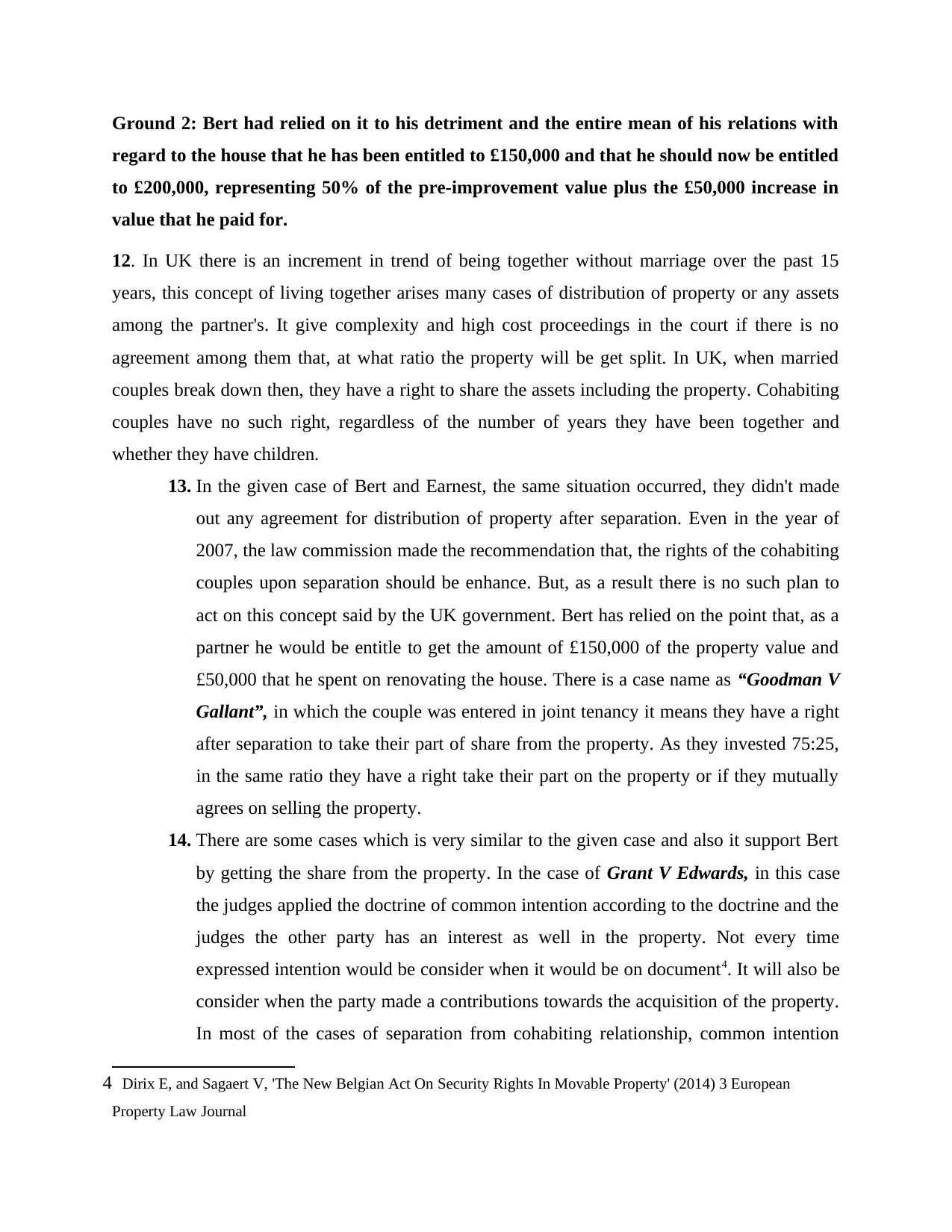
Ground 2: Bert had relied on it to his detriment and the entire mean of his relations with
regard to the house that he has been entitled to £150,000 and that he should now be entitled
to £200,000, representing 50% of the pre-improvement value plus the £50,000 increase in
value that he paid for.
12. In UK there is an increment in trend of being together without marriage over the past 15
years, this concept of living together arises many cases of distribution of property or any assets
among the partner's. It give complexity and high cost proceedings in the court if there is no
agreement among them that, at what ratio the property will be get split. In UK, when married
couples break down then, they have a right to share the assets including the property. Cohabiting
couples have no such right, regardless of the number of years they have been together and
whether they have children.
13. In the given case of Bert and Earnest, the same situation occurred, they didn't made
out any agreement for distribution of property after separation. Even in the year of
2007, the law commission made the recommendation that, the rights of the cohabiting
couples upon separation should be enhance. But, as a result there is no such plan to
act on this concept said by the UK government. Bert has relied on the point that, as a
partner he would be entitle to get the amount of £150,000 of the property value and
£50,000 that he spent on renovating the house. There is a case name as “Goodman V
Gallant”, in which the couple was entered in joint tenancy it means they have a right
after separation to take their part of share from the property. As they invested 75:25,
in the same ratio they have a right take their part on the property or if they mutually
agrees on selling the property.
14. There are some cases which is very similar to the given case and also it support Bert
by getting the share from the property. In the case of Grant V Edwards, in this case
the judges applied the doctrine of common intention according to the doctrine and the
judges the other party has an interest as well in the property. Not every time
expressed intention would be consider when it would be on document4. It will also be
consider when the party made a contributions towards the acquisition of the property.
In most of the cases of separation from cohabiting relationship, common intention
4 Dirix E, and Sagaert V, 'The New Belgian Act On Security Rights In Movable Property' (2014) 3 European
Property Law Journal
regard to the house that he has been entitled to £150,000 and that he should now be entitled
to £200,000, representing 50% of the pre-improvement value plus the £50,000 increase in
value that he paid for.
12. In UK there is an increment in trend of being together without marriage over the past 15
years, this concept of living together arises many cases of distribution of property or any assets
among the partner's. It give complexity and high cost proceedings in the court if there is no
agreement among them that, at what ratio the property will be get split. In UK, when married
couples break down then, they have a right to share the assets including the property. Cohabiting
couples have no such right, regardless of the number of years they have been together and
whether they have children.
13. In the given case of Bert and Earnest, the same situation occurred, they didn't made
out any agreement for distribution of property after separation. Even in the year of
2007, the law commission made the recommendation that, the rights of the cohabiting
couples upon separation should be enhance. But, as a result there is no such plan to
act on this concept said by the UK government. Bert has relied on the point that, as a
partner he would be entitle to get the amount of £150,000 of the property value and
£50,000 that he spent on renovating the house. There is a case name as “Goodman V
Gallant”, in which the couple was entered in joint tenancy it means they have a right
after separation to take their part of share from the property. As they invested 75:25,
in the same ratio they have a right take their part on the property or if they mutually
agrees on selling the property.
14. There are some cases which is very similar to the given case and also it support Bert
by getting the share from the property. In the case of Grant V Edwards, in this case
the judges applied the doctrine of common intention according to the doctrine and the
judges the other party has an interest as well in the property. Not every time
expressed intention would be consider when it would be on document4. It will also be
consider when the party made a contributions towards the acquisition of the property.
In most of the cases of separation from cohabiting relationship, common intention
4 Dirix E, and Sagaert V, 'The New Belgian Act On Security Rights In Movable Property' (2014) 3 European
Property Law Journal
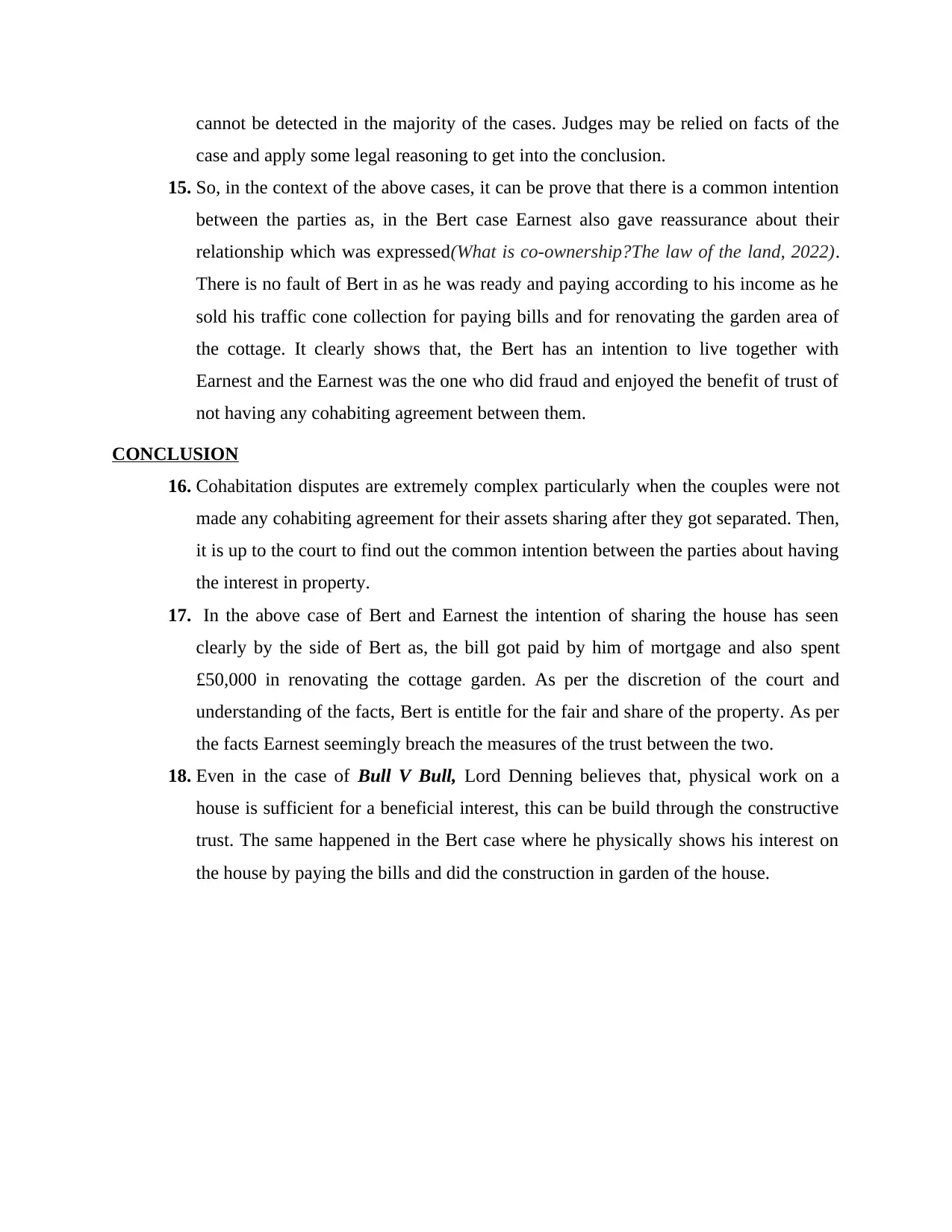
cannot be detected in the majority of the cases. Judges may be relied on facts of the
case and apply some legal reasoning to get into the conclusion.
15. So, in the context of the above cases, it can be prove that there is a common intention
between the parties as, in the Bert case Earnest also gave reassurance about their
relationship which was expressed(What is co-ownership?The law of the land, 2022).
There is no fault of Bert in as he was ready and paying according to his income as he
sold his traffic cone collection for paying bills and for renovating the garden area of
the cottage. It clearly shows that, the Bert has an intention to live together with
Earnest and the Earnest was the one who did fraud and enjoyed the benefit of trust of
not having any cohabiting agreement between them.
CONCLUSION
16. Cohabitation disputes are extremely complex particularly when the couples were not
made any cohabiting agreement for their assets sharing after they got separated. Then,
it is up to the court to find out the common intention between the parties about having
the interest in property.
17. In the above case of Bert and Earnest the intention of sharing the house has seen
clearly by the side of Bert as, the bill got paid by him of mortgage and also spent
£50,000 in renovating the cottage garden. As per the discretion of the court and
understanding of the facts, Bert is entitle for the fair and share of the property. As per
the facts Earnest seemingly breach the measures of the trust between the two.
18. Even in the case of Bull V Bull, Lord Denning believes that, physical work on a
house is sufficient for a beneficial interest, this can be build through the constructive
trust. The same happened in the Bert case where he physically shows his interest on
the house by paying the bills and did the construction in garden of the house.
case and apply some legal reasoning to get into the conclusion.
15. So, in the context of the above cases, it can be prove that there is a common intention
between the parties as, in the Bert case Earnest also gave reassurance about their
relationship which was expressed(What is co-ownership?The law of the land, 2022).
There is no fault of Bert in as he was ready and paying according to his income as he
sold his traffic cone collection for paying bills and for renovating the garden area of
the cottage. It clearly shows that, the Bert has an intention to live together with
Earnest and the Earnest was the one who did fraud and enjoyed the benefit of trust of
not having any cohabiting agreement between them.
CONCLUSION
16. Cohabitation disputes are extremely complex particularly when the couples were not
made any cohabiting agreement for their assets sharing after they got separated. Then,
it is up to the court to find out the common intention between the parties about having
the interest in property.
17. In the above case of Bert and Earnest the intention of sharing the house has seen
clearly by the side of Bert as, the bill got paid by him of mortgage and also spent
£50,000 in renovating the cottage garden. As per the discretion of the court and
understanding of the facts, Bert is entitle for the fair and share of the property. As per
the facts Earnest seemingly breach the measures of the trust between the two.
18. Even in the case of Bull V Bull, Lord Denning believes that, physical work on a
house is sufficient for a beneficial interest, this can be build through the constructive
trust. The same happened in the Bert case where he physically shows his interest on
the house by paying the bills and did the construction in garden of the house.
Paraphrase This Document
Need a fresh take? Get an instant paraphrase of this document with our AI Paraphraser
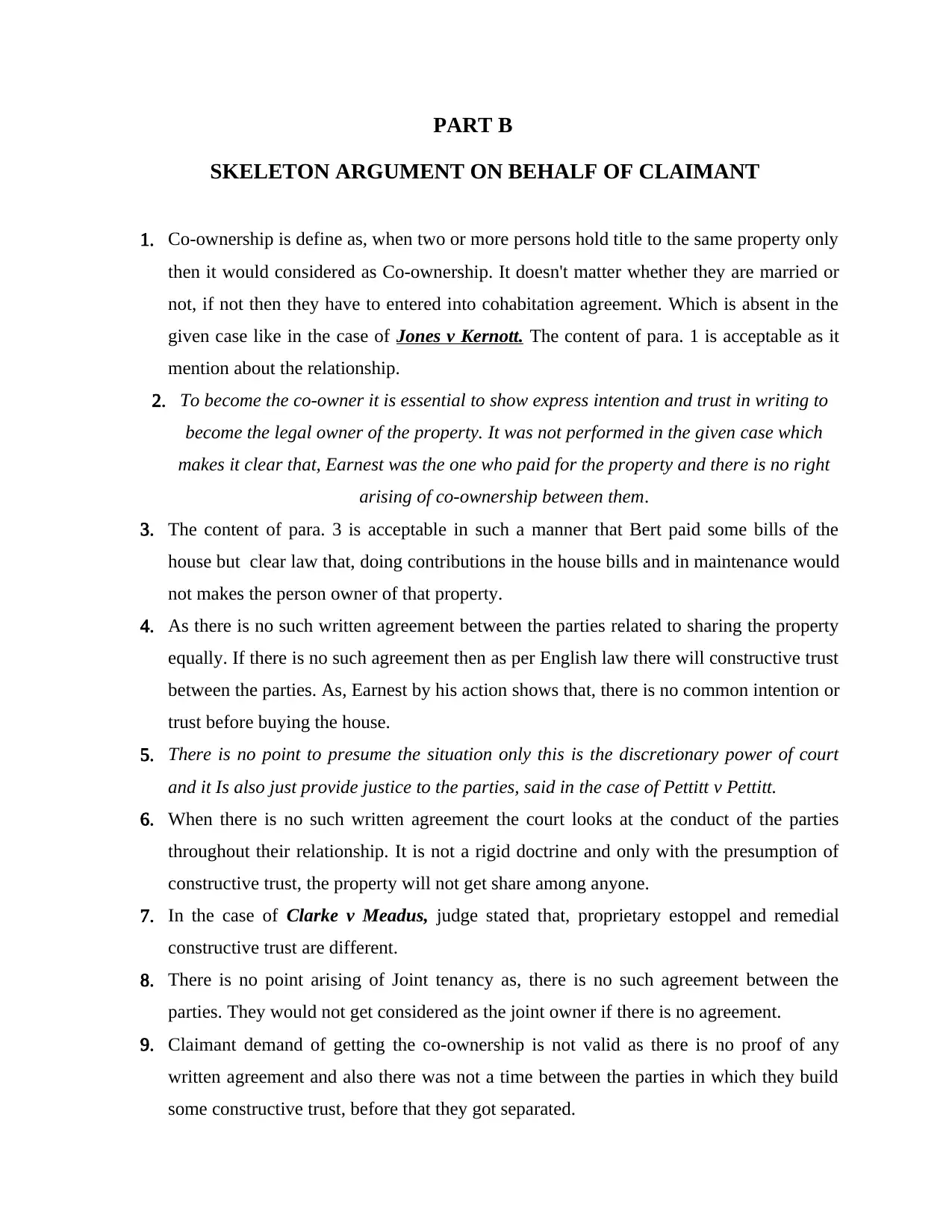
PART B
SKELETON ARGUMENT ON BEHALF OF CLAIMANT
1. Co-ownership is define as, when two or more persons hold title to the same property only
then it would considered as Co-ownership. It doesn't matter whether they are married or
not, if not then they have to entered into cohabitation agreement. Which is absent in the
given case like in the case of Jones v Kernott. The content of para. 1 is acceptable as it
mention about the relationship.
2. To become the co-owner it is essential to show express intention and trust in writing to
become the legal owner of the property. It was not performed in the given case which
makes it clear that, Earnest was the one who paid for the property and there is no right
arising of co-ownership between them.
3. The content of para. 3 is acceptable in such a manner that Bert paid some bills of the
house but clear law that, doing contributions in the house bills and in maintenance would
not makes the person owner of that property.
4. As there is no such written agreement between the parties related to sharing the property
equally. If there is no such agreement then as per English law there will constructive trust
between the parties. As, Earnest by his action shows that, there is no common intention or
trust before buying the house.
5. There is no point to presume the situation only this is the discretionary power of court
and it Is also just provide justice to the parties, said in the case of Pettitt v Pettitt.
6. When there is no such written agreement the court looks at the conduct of the parties
throughout their relationship. It is not a rigid doctrine and only with the presumption of
constructive trust, the property will not get share among anyone.
7. In the case of Clarke v Meadus, judge stated that, proprietary estoppel and remedial
constructive trust are different.
8. There is no point arising of Joint tenancy as, there is no such agreement between the
parties. They would not get considered as the joint owner if there is no agreement.
9. Claimant demand of getting the co-ownership is not valid as there is no proof of any
written agreement and also there was not a time between the parties in which they build
some constructive trust, before that they got separated.
SKELETON ARGUMENT ON BEHALF OF CLAIMANT
1. Co-ownership is define as, when two or more persons hold title to the same property only
then it would considered as Co-ownership. It doesn't matter whether they are married or
not, if not then they have to entered into cohabitation agreement. Which is absent in the
given case like in the case of Jones v Kernott. The content of para. 1 is acceptable as it
mention about the relationship.
2. To become the co-owner it is essential to show express intention and trust in writing to
become the legal owner of the property. It was not performed in the given case which
makes it clear that, Earnest was the one who paid for the property and there is no right
arising of co-ownership between them.
3. The content of para. 3 is acceptable in such a manner that Bert paid some bills of the
house but clear law that, doing contributions in the house bills and in maintenance would
not makes the person owner of that property.
4. As there is no such written agreement between the parties related to sharing the property
equally. If there is no such agreement then as per English law there will constructive trust
between the parties. As, Earnest by his action shows that, there is no common intention or
trust before buying the house.
5. There is no point to presume the situation only this is the discretionary power of court
and it Is also just provide justice to the parties, said in the case of Pettitt v Pettitt.
6. When there is no such written agreement the court looks at the conduct of the parties
throughout their relationship. It is not a rigid doctrine and only with the presumption of
constructive trust, the property will not get share among anyone.
7. In the case of Clarke v Meadus, judge stated that, proprietary estoppel and remedial
constructive trust are different.
8. There is no point arising of Joint tenancy as, there is no such agreement between the
parties. They would not get considered as the joint owner if there is no agreement.
9. Claimant demand of getting the co-ownership is not valid as there is no proof of any
written agreement and also there was not a time between the parties in which they build
some constructive trust, before that they got separated.
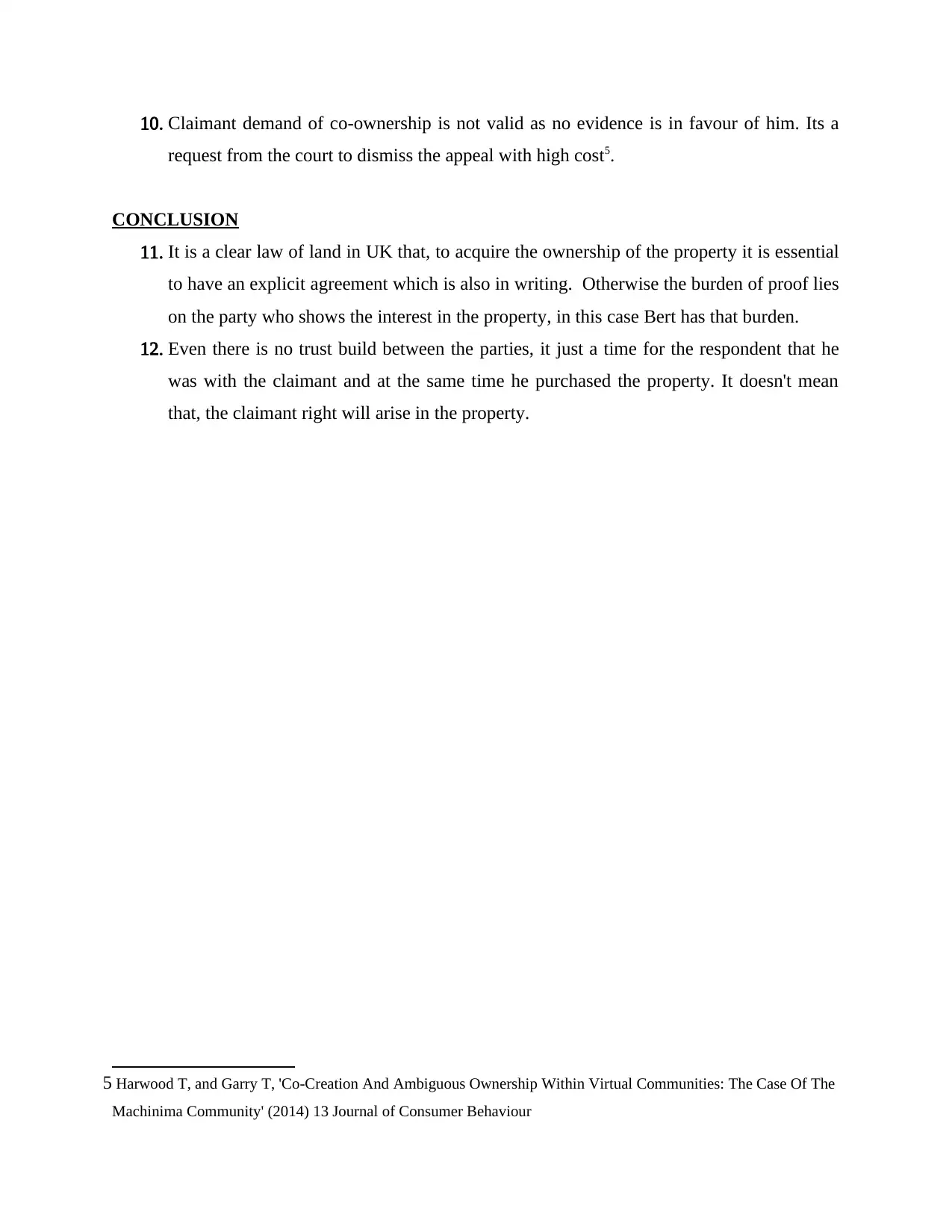
10. Claimant demand of co-ownership is not valid as no evidence is in favour of him. Its a
request from the court to dismiss the appeal with high cost5.
CONCLUSION
11. It is a clear law of land in UK that, to acquire the ownership of the property it is essential
to have an explicit agreement which is also in writing. Otherwise the burden of proof lies
on the party who shows the interest in the property, in this case Bert has that burden.
12. Even there is no trust build between the parties, it just a time for the respondent that he
was with the claimant and at the same time he purchased the property. It doesn't mean
that, the claimant right will arise in the property.
5 Harwood T, and Garry T, 'Co-Creation And Ambiguous Ownership Within Virtual Communities: The Case Of The
Machinima Community' (2014) 13 Journal of Consumer Behaviour
request from the court to dismiss the appeal with high cost5.
CONCLUSION
11. It is a clear law of land in UK that, to acquire the ownership of the property it is essential
to have an explicit agreement which is also in writing. Otherwise the burden of proof lies
on the party who shows the interest in the property, in this case Bert has that burden.
12. Even there is no trust build between the parties, it just a time for the respondent that he
was with the claimant and at the same time he purchased the property. It doesn't mean
that, the claimant right will arise in the property.
5 Harwood T, and Garry T, 'Co-Creation And Ambiguous Ownership Within Virtual Communities: The Case Of The
Machinima Community' (2014) 13 Journal of Consumer Behaviour
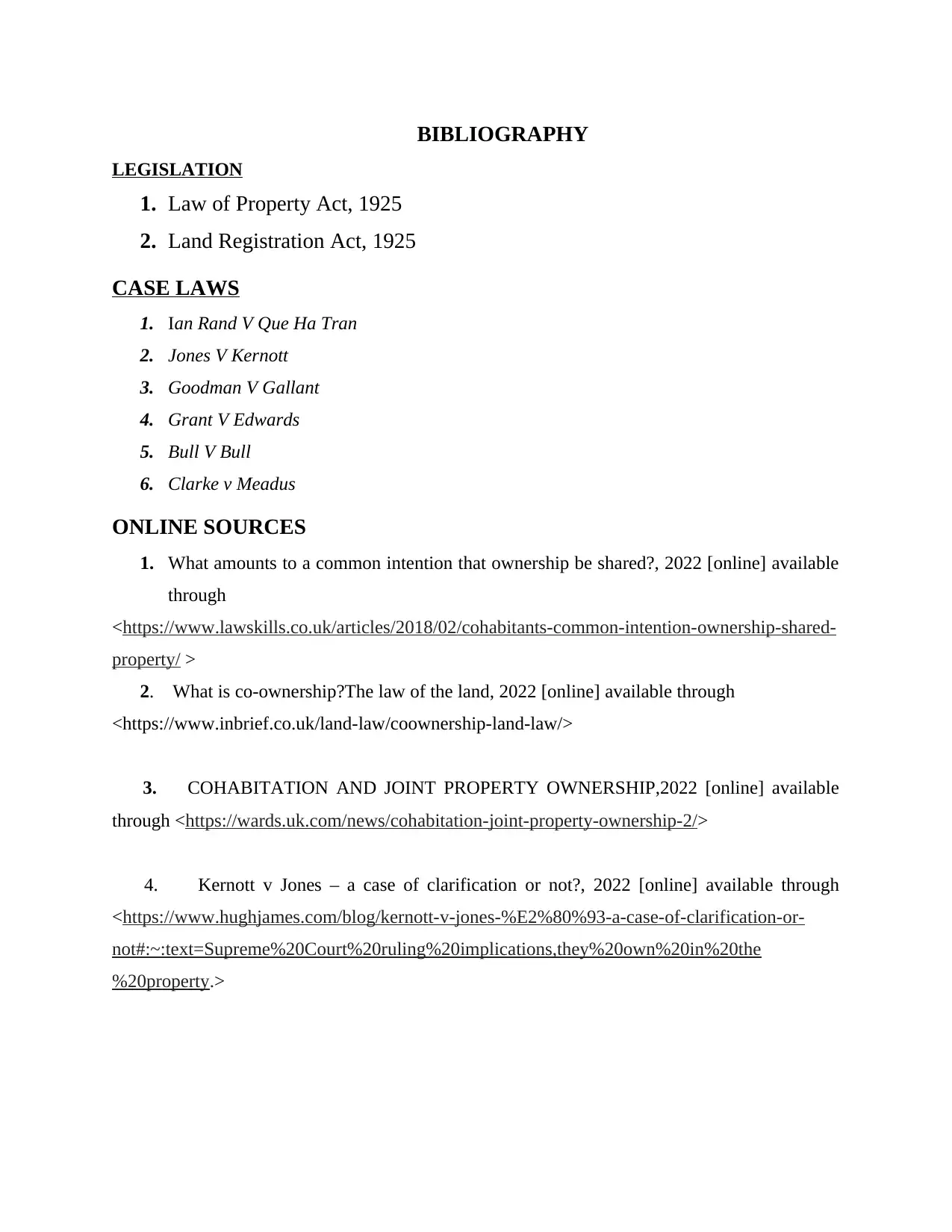
BIBLIOGRAPHY
LEGISLATION
1. Law of Property Act, 1925
2. Land Registration Act, 1925
CASE LAWS
1. Ian Rand V Que Ha Tran
2. Jones V Kernott
3. Goodman V Gallant
4. Grant V Edwards
5. Bull V Bull
6. Clarke v Meadus
ONLINE SOURCES
1. What amounts to a common intention that ownership be shared?, 2022 [online] available
through
<https://www.lawskills.co.uk/articles/2018/02/cohabitants-common-intention-ownership-shared-
property/ >
2. What is co-ownership?The law of the land, 2022 [online] available through
<https://www.inbrief.co.uk/land-law/coownership-land-law/>
3. COHABITATION AND JOINT PROPERTY OWNERSHIP,2022 [online] available
through <https://wards.uk.com/news/cohabitation-joint-property-ownership-2/>
4. Kernott v Jones – a case of clarification or not?, 2022 [online] available through
<https://www.hughjames.com/blog/kernott-v-jones-%E2%80%93-a-case-of-clarification-or-
not#:~:text=Supreme%20Court%20ruling%20implications,they%20own%20in%20the
%20property.>
LEGISLATION
1. Law of Property Act, 1925
2. Land Registration Act, 1925
CASE LAWS
1. Ian Rand V Que Ha Tran
2. Jones V Kernott
3. Goodman V Gallant
4. Grant V Edwards
5. Bull V Bull
6. Clarke v Meadus
ONLINE SOURCES
1. What amounts to a common intention that ownership be shared?, 2022 [online] available
through
<https://www.lawskills.co.uk/articles/2018/02/cohabitants-common-intention-ownership-shared-
property/ >
2. What is co-ownership?The law of the land, 2022 [online] available through
<https://www.inbrief.co.uk/land-law/coownership-land-law/>
3. COHABITATION AND JOINT PROPERTY OWNERSHIP,2022 [online] available
through <https://wards.uk.com/news/cohabitation-joint-property-ownership-2/>
4. Kernott v Jones – a case of clarification or not?, 2022 [online] available through
<https://www.hughjames.com/blog/kernott-v-jones-%E2%80%93-a-case-of-clarification-or-
not#:~:text=Supreme%20Court%20ruling%20implications,they%20own%20in%20the
%20property.>
Secure Best Marks with AI Grader
Need help grading? Try our AI Grader for instant feedback on your assignments.
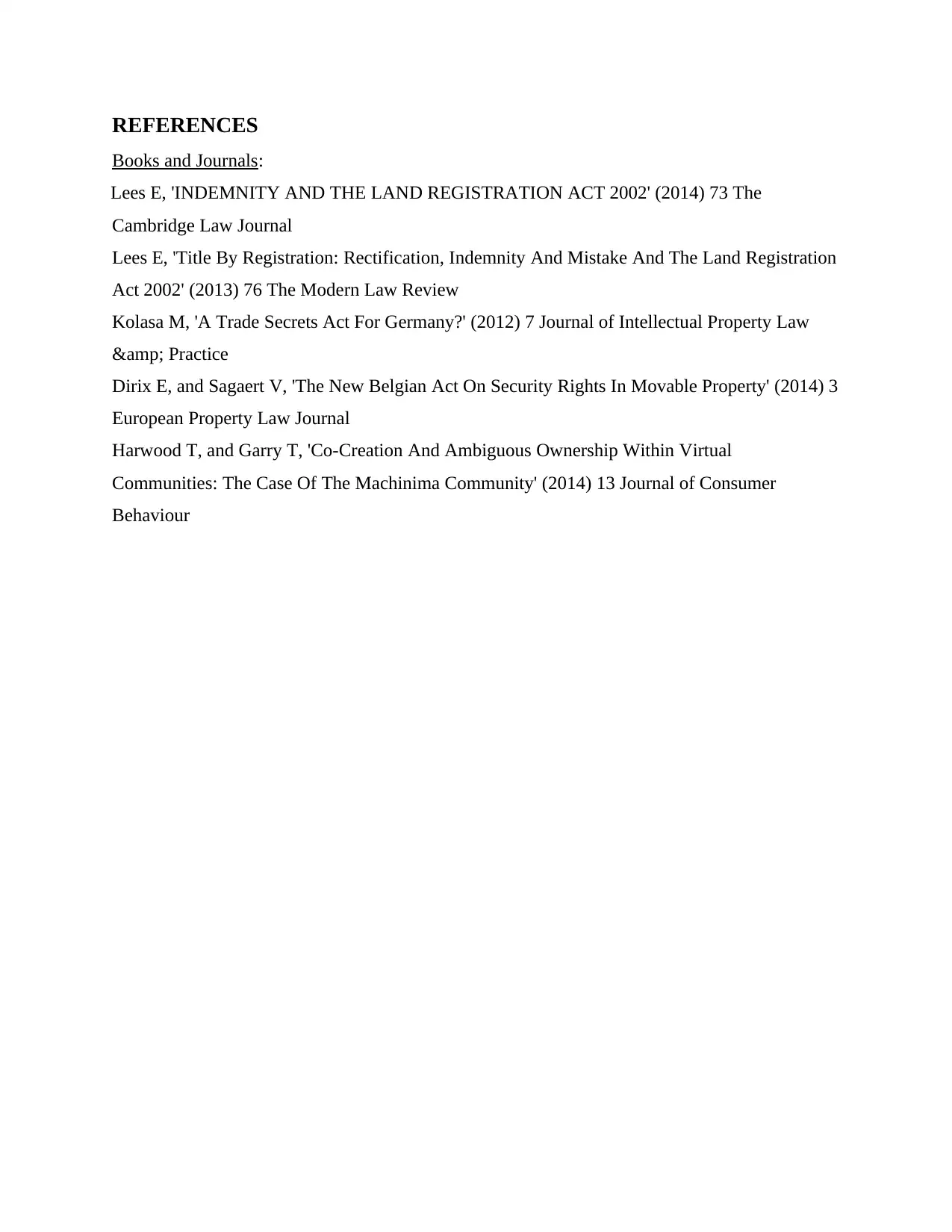
REFERENCES
Books and Journals:
Lees E, 'INDEMNITY AND THE LAND REGISTRATION ACT 2002' (2014) 73 The
Cambridge Law Journal
Lees E, 'Title By Registration: Rectification, Indemnity And Mistake And The Land Registration
Act 2002' (2013) 76 The Modern Law Review
Kolasa M, 'A Trade Secrets Act For Germany?' (2012) 7 Journal of Intellectual Property Law
& Practice
Dirix E, and Sagaert V, 'The New Belgian Act On Security Rights In Movable Property' (2014) 3
European Property Law Journal
Harwood T, and Garry T, 'Co-Creation And Ambiguous Ownership Within Virtual
Communities: The Case Of The Machinima Community' (2014) 13 Journal of Consumer
Behaviour
Books and Journals:
Lees E, 'INDEMNITY AND THE LAND REGISTRATION ACT 2002' (2014) 73 The
Cambridge Law Journal
Lees E, 'Title By Registration: Rectification, Indemnity And Mistake And The Land Registration
Act 2002' (2013) 76 The Modern Law Review
Kolasa M, 'A Trade Secrets Act For Germany?' (2012) 7 Journal of Intellectual Property Law
& Practice
Dirix E, and Sagaert V, 'The New Belgian Act On Security Rights In Movable Property' (2014) 3
European Property Law Journal
Harwood T, and Garry T, 'Co-Creation And Ambiguous Ownership Within Virtual
Communities: The Case Of The Machinima Community' (2014) 13 Journal of Consumer
Behaviour
1 out of 11
Your All-in-One AI-Powered Toolkit for Academic Success.
+13062052269
info@desklib.com
Available 24*7 on WhatsApp / Email
![[object Object]](/_next/static/media/star-bottom.7253800d.svg)
Unlock your academic potential
© 2024 | Zucol Services PVT LTD | All rights reserved.